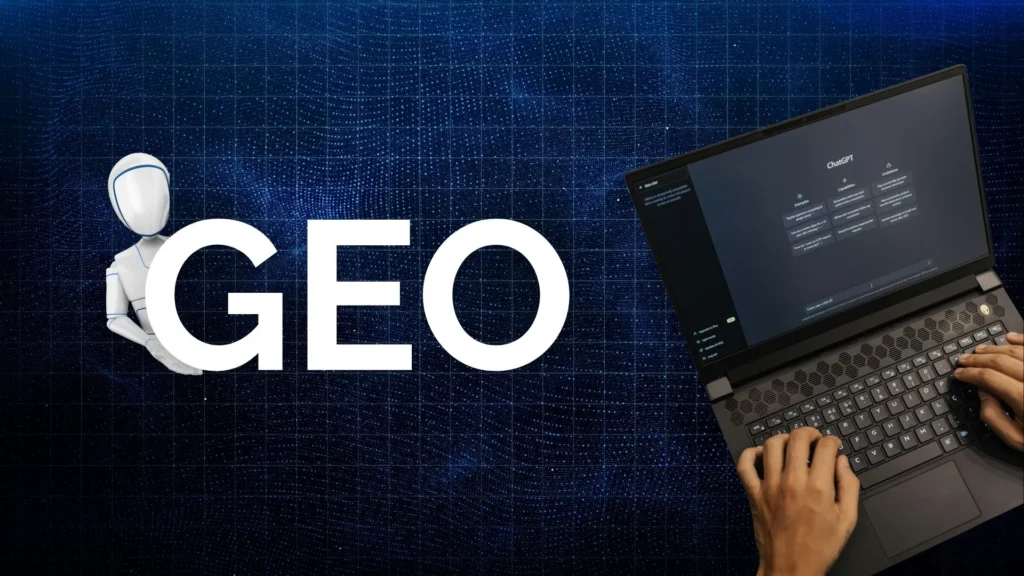Since the beginning of online search, the way search engines find and present answers has constantly evolved. Right now, we’re in the middle of one of the biggest shifts yet.
Tools like ChatGPT and other LLMs (Large Language Models) are becoming a go-to for the kinds of searches Google used to dominate.
Enter GEO.
GEO stands for Generative Engine Optimization. Like SEO, it’s about improving organic visibility online. But instead of ranking on Google, GEO is about getting picked up by AI models and showing up in the answers they generate.
In this post, I’ll go over what GEO really is, really isn’t, and what you can start doing now to position your business (or personal brand) for success with AI-driven search.
What GEO REALLY Is
The main goal of GEO is to get your website content best optimized for large language models (LLMs) like ChatGPT and AI search tools like Google’s AI Overview and AI Mode. This way they can find and reference your brand, products, or expertise in their answers.
Unlike SEO, where the goal is to rank in a search engine results page (SERP), GEO focuses on how AI models generate answers based on large-scale content they’ve been trained on.
As Foundation Marketing puts it, GEO is about being present in the training data or trusted sources that LLMs use to respond.
One of the most prevalent questions I’ve seen thrown around lately is, “Will GEO replace traditional SEO?”
Short answer: No.
SEO isn’t going anywhere, in fact, GEO and SEO work best together. Strong SEO helps you show up in AI answers, and GEO helps you shape content that LLMs can understand and cite.
The “SEO is dead” takes are mostly noise meant to grab attention during this AI wave.
Now let’s get into how to truly optimize your website content for LLMs, and which GEO practices are actually worth your time.
How To Do GEO That Works
Like I mentioned earlier, most traditional SEO work still helps you show up in generative search. If you want to boost your odds of being referenced by LLMs, here are some of the most important factors to keep in mind.
Understand Search Intent
Search intent is the reason behind a user’s search query. It’s one of the most important foundations for optimizing content for both traditional search and generative engines. And with GEO in mind, AI takes context into account better than traditional search engines. The content that best matches the searcher’s goal and clearly answers the related questions is the content most likely to be surfaced.

The four main search intent types are:
- Informational: who, what, when, where, why, how
- Commercial: best, top rated, X vs. Y, reviews, comparisons
- Transactional: price, buy, cheap, coupons, free trial
- Navigational: brand or site names
Now that you understand this, how do you implement it in practice? Say you sell a product online:
- First, your pages aimed for bottom-of-funnel (ready to buy now) should be optimized for transactional searches.
- Create commercial and informational content to educate buyers earlier in the funnel. (Guides, comparison lists, blog posts, etc.)
- Ensure your navigational pages (home, categories, etc.) clearly satisfy and are optimized for branded searches.
Make Q&A Formatted Content
Question-and-answer sections work well for GEO because AI systems look for short, self-contained passages that directly answer a query. Clear Q&A pairs make it easier for engines to extract, quote, and cite the relevant snippet.

Independent analyses of AI Overviews show that Google’s summaries pull from scannable passages and display citations to sources. Structuring content as short answers, bullets, and definition blocks increases the chance of being referenced.
What does Q&A content format look like
Use it as a block in relevant pages (don’t force it on everything):
- Put the question in an H2 or H3. Think to yourself, how would I ask this question?
- Lead with a direct, two-to-three-sentence answer, followed by supporting details or bullets.
- Add a short “Key takeaways” line when it helps scanning.
- Hyperlink to a primary source when you cite data.
Q&A Example (on-page):
- H2: What is Generative Engine Optimization (GEO)?
GEO is the practice of structuring and marking up content so AI systems can understand, retrieve, and cite it in generated answers. It focuses on clear passages, schema, and topical authority.
Brand Authority and Digital PR
Building brand authority is one of the biggest levers for both traditional SEO and GEO. When your brand is recognized as an expert source, you’re more likely to be surfaced in Search and cited by AI answers. There’s also strong evidence that what wins in classic SEO often powers visibility in AI summaries. In a study of 1.9M citations from 1M Google AI Overviews, 76% of cited pages already ranked in the top 10 organic results.

How do you build authority to help your organic rankings? That’s where Digital PR comes in. Digital PR is the practice of earning authoritative coverage and backlinks (link from another website to yours) by creating and sharing genuinely newsworthy content. Some examples are original research, data studies, tools, expert commentary, standout visuals, etc. Even Google’s John Mueller has said that digital PR can be “just as critical as tech SEO, probably more so.”
When building backlinks to your content, focus your efforts on reputable and relevant sites. Avoid black-hat tactics and focus on building links naturally through high-quality content and outreach.
GEO Quick-Tips
- Own your niche. Publish authoritative content on specific topics. LLMs reward clear content that answers long-tail keyword based queries.
- Be quotable. Write sentences and paragraphs that read like ready-made answers. AI tools often pull concise, structured explanations.
- Use structured data. Schema markup helps models understand context and improves your chances of being included in knowledge graphs.
- Distribute and monitor. Share your content on blogs, podcasts and social media. Monitor how AI models reference your brand using analytics tools like Writesonic or Surfer AI, and adjust your strategy based on what gets cited.
- Prioritize authenticity and transparency. AI tools often prefer clear, trustworthy sources.
Wrapping Up
GEO is not a replacement for SEO, It’s a new layer on top of it. Search is shifting toward answers generated by AI, but the pages those systems trust still look a lot like the pages that rank well in traditional search. Clear intent, clean structure, strong sources, and real authority win in both places.
If you remember one idea, make it this: write and structure content so a human can scan it in seconds and a machine can parse it without guessing. That means straightforward questions and answers, concise definitions, and sections that map to a single intent. Do the fundamentals well, then make it easy for LLMs to understand and quote you. That is the heart of GEO.






